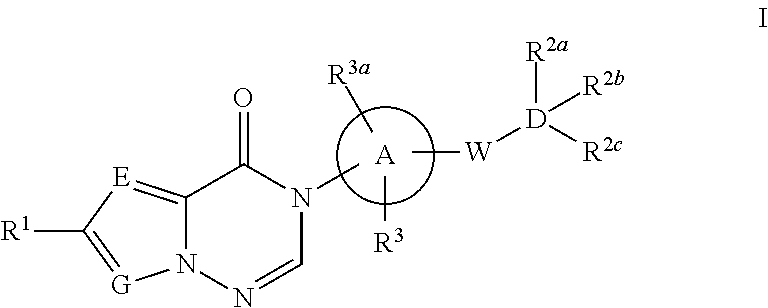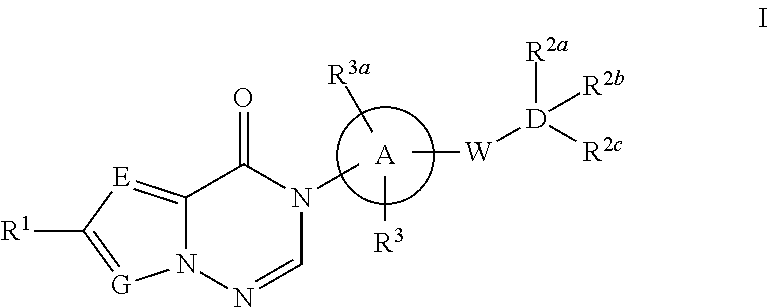Azolotriazinone melanin concentrating hormone receptor-1 antagonists
a technology of concentrating hormone receptor and azolotriazinone, which is applied in the direction of drug composition, biocide, metabolic disorder, etc., can solve the problems of increased food intake, weight loss, and decreased feeding in diet-induced obese mi
- Summary
- Abstract
- Description
- Claims
- Application Information
AI Technical Summary
Benefits of technology
Problems solved by technology
Method used
Image
Examples
example 1a
2-Trichloroacetylpyrrole
[0299]
[0300]To trichloroacetyl chloride (48 mL; 0.43 mol) taken in anhydrous ether (150 mL) under nitrogen was added pyrrole (25 g, 0.37 mol) dissolved in anhydrous ether (500 mL) through a dropping funnel over a 2-hour period. The violet ether solution began to reflux during addition. Refluxing was continued for 1 h before the reaction was quenched with a solution of sodium carbonate (33 g, 0.31 mol) in water (200 mL). The layers were separated and the red organic layer was washed four times with water (4×50 mL) and once with brine (1×50 mL) and finally dried over anhydrous sodium sulphate. The red ether solution was then filtered through CELITE® and washed with ether. The solvent was removed under vacuum to afford 2-trichloroacetylpyrrole (Example 1A, 72 g, 91% yield).) as an ash colored solid (72 g, 91% yield). LC-MS, [M−H]+=212. 1H NMR (DMSO-d6, 300 MHz): δ 9.63 (brs, 1H), 7.39 (m, 1H), 7.19 (m, 1H), 6.40 (m, 1H).
example 1b
4-Bromo-2-trichloroacetylpyrrole
[0301]
[0302]To a solution of Example 1A (21.2 g, 99 mmol) in CHCl3 (100 mL), cooled in an ice-bath, bromine (17 g, 106 mmol) was added dropwise. The resulting solution was stirred at ambient temperature for 10 min and then poured into water. The organic phase was separated, washed with saturated aq. NaHCO3 (50 mL) and water (50 mL), dried (MgSO4) and evaporated under reduced pressure. Recrystallization of the residue from hexane gave the product 4-bromo-2-trichloroacetylpyrrole (Example 1B, 21 g, 73%) as an off-white solid. LC-MS, [M−H]+=289. 1H NMR (DMSO-d6, 300 MHz): δ 12.9 (brs, 1H), 7.55 (s, 1H), 7.31 (s, 1H).
example 1c
4-Bromo-2-methoxycarbonylpyrrole
[0303]
[0304]To a solution of Example 1B (20 g, 68 mmol) in methanol (100 mL), a solution of NaOMe (1M in MeOH, 34 mL, 34 mmol) was added slowly. This mixture was then stirred at ambient temperature for 1 h after which it was diluted with water (300 mL) and the organic layer was separated. The aqueous phase was extracted with CH2Cl2 and the combined organic layer and extracts were washed with water (2×50 mL), dried (MgSO4) and evaporated under reduced pressure. Recrystallization of the residue from hexane gave 4-Bromo-2-methoxycarbonylpyrrole (Example 1C, 12 g, 85%) as a white solid. LC-MS, [M−H]+=203. 1H NMR (DMSO-d6, 400 MHz): δ 12.31 (brs, 1H), 7.16 (s, 1H), 6.81 (s, 1H), 3.75 (s, 3H).
PUM
| Property | Measurement | Unit |
|---|---|---|
| temperature | aaaaa | aaaaa |
| mol % | aaaaa | aaaaa |
| flow rate | aaaaa | aaaaa |
Abstract
Description
Claims
Application Information
 Login to View More
Login to View More - R&D
- Intellectual Property
- Life Sciences
- Materials
- Tech Scout
- Unparalleled Data Quality
- Higher Quality Content
- 60% Fewer Hallucinations
Browse by: Latest US Patents, China's latest patents, Technical Efficacy Thesaurus, Application Domain, Technology Topic, Popular Technical Reports.
© 2025 PatSnap. All rights reserved.Legal|Privacy policy|Modern Slavery Act Transparency Statement|Sitemap|About US| Contact US: help@patsnap.com



